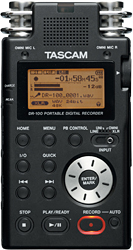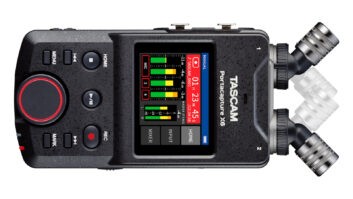
TASCAM DR-100
In a world where it seems a new handheld portable digital recorder comes out weekly, TASCAM has released a new contender. The DR-100 offers a bevy of features at a competitive price, including some that are unique to its class. Standout features include two sets of internal mics (one omni and one cardioid), two batteries, a simple remote that can be used either wired or wirelessly, a built-in speaker, a dedicated peak LED, and XLR mic/line inputs. It records to an included 2 GB SD card or an inexpensive SDHC card that holds up to 32 GB. A dual-battery backup system allows for long battery life; while recording, you can change one battery—which means unlimited use in the field.
The DR-100’s interface and controls were intuitive and easy to use. On TASCAM’s Website I noticed a new firmware upgrade that allows 96kHz recording, so I downloaded the update. The well-written PDF manual addendum/procedure made the upgrade a breeze. As a simple handheld capture device in the field, the DR-100 handled the chore elegantly. It was easy to set levels and see what I was getting thanks to the generous onscreen LED meter and dedicated peak light. To torture test the unit, I kicked in the auto/limiter and introduced some plosives and high SPL into the mics. On playback I noticed that it quickly clamped down on the peaks as advertised. I liked the DR-100’s immediate playback via the onboard speaker.
Next, I recorded a live band using both the internal omni and directional mics with less than satisfactory results. Compared to what I heard at the unit, which was placed about 40 feet back from the stage, the output seemed rolled off in the low end, piercing and thin at the top end and a bit phase-y. (Click here to download the “Internal Mics” audio sample as a WAV file; and click here for the “Internal Mics” MP3 file). I was purposely conservative in my level settings, giving the converters plenty of “benefit of the doubt” headroom. But even though my peaks were -10 dB down from FS, there were artifacts and oddities when the drummer went to the bell of his ride.
When I recorded the same band using a Royer SF-24V plugged into the XLR inputs, essentially using the DR-100 as a mic preamp/converter and storage unit, the results were excellent (click here to listen to the results with the Royer SF-24V as a WAV file; and click here to download an MP3 file of the Royer SF-24V results). The stereo image improved greatly, as did the bandwidth. The low-end sounded full and the mix was balanced and sounded very close to what I heard in the room. I next took a live feed from the board into the XLR inputs, re-adjusted the levels and the results were equally as good (click here to download the live board feed sample as a WAV file; and click here for the “Live From Board” MP3 file.)
The DR-100 offers a fat set of features for its affordable pricing (click here to download Mix’s portable recorder comparison chart). Although I was disappointed with using the DR-100’s internal mics for recording music, it shined as a handheld unit for basic recording and as a preamp/converter/recorder using external microphones. The unit’s onboard extras—such as the speaker, remote and abundance of I/O possibilities—are definite pluses, making the DR-100 a true contender in its class.
For more information, visit www.tascam.com/products/dr-100.html.
Kevin Becka is Mix magazine’s technical editor.








